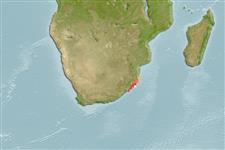Пластиножаберные (акулы и скаты) (sharks and rays) >
Rajiformes (Skates and rays) >
Gurgesiellidae (Pygmy skates)
Etymology: Cruriraja: Latin, crur, cruris = pertaining to a leg + Latin, raja = a ray (Raja sp) (Ref. 45335).
Environment: milieu / climate zone / depth range / distribution range
экология
морской батидемерсальный; пределы глубины 150 - 620 m (Ref. 11284). Deep-water; 28°S - 40°S
Western Indian Ocean: KwaZulu-Natal, South Africa to Mozambique. Previous records from Namibia to the Eastern Cape Coast of South Africa refer to Cruriraja hulleyi.
Size / Вес / Возраст
Maturity: Lm ? range ? - ? cm
Max length : 55.0 cm TL самец/пол неопределен; (Ref. 5578)
Краткое описание
определительные ключи | морфология | морфометрия
A rough legskate with a pointed snout covered by large conspicuous white thorns that are also found around the eyes, on the shoulders, and in several rows from the nape to the 1st dorsal fin (Ref. 5578). Legskates have pelvic fins separated into a mobile leg-like front lobe, and a rear lobe that may be fused to the tail base (Ref. 5578). Sandy brown above usually with scattered dark brown and whitish spots (very conspicuous in young and becoming obscure in adults; white below (Ref. 5578). Tail with conspicuous dark brown bandings in juveniles (Ref. 5578).
Found on the uppermost slope (Ref. 5578). Feed on small crustaceans, dragonets, squid, polychaete worms and flatworms (Ref. 5578). Oviparous. Distinct pairing with embrace. Young may tend to follow large objects, such as their mother (Ref. 205). Eggs are oblong capsules with stiff pointed horns at the corners deposited in sandy or muddy flats (Ref. 205). Egg capsules are 4.5 cm long and 2.4 cm wide (Ref. 41249). Caught by hake bottom trawlers (Ref. 5578).
Life cycle and mating behavior
половая зрелость | размножение | нерест | икра | Fecundity | личинки
Oviparous, paired eggs are laid. Embryos feed solely on yolk (Ref. 50449). Distinct pairing with embrace. Young may tend to follow large objects, such as their mother (Ref. 205).
McEachran, J.D. and K.A. Dunn, 1998. Phylogenetic analysis of skates, a morphologically conservative clade of elasmobranchs (Chondrichthyes: Rajidae). Copeia 1998(2):271-290. (Ref. 27314)
Статус Красного Списка МСОП (Ref. 130435: Version 2024-1)
Угроза для людей
Harmless
Использование человеком
рыболовство:
дополнительная информация
инструменты
Специальные отчеты
Скачать в формате XML
ресурсы в Интернет
Estimates based on models
Preferred temperature (Ref.
123201): 11.7 - 17.9, mean 15.8 °C (based on 5 cells).
Phylogenetic diversity index (Ref.
82804): PD
50 = 0.5039 [Uniqueness, from 0.5 = low to 2.0 = high].
Bayesian length-weight: a=0.00661 (0.00222 - 0.01969), b=2.95 (2.71 - 3.19), in cm total length, based on LWR estimates for this (Sub)family-body shape (Ref.
93245).
Trophic level (Ref.
69278): 3.6 ±0.53 se; based on food items.
устойчивость к внешним воздействиям (Ref.
120179): низкий, минимальное время удвоения популяции 4.5-14 лет (Fec assumed to be <100).
Fishing Vulnerability (Ref.
59153): Moderate vulnerability (42 of 100).
